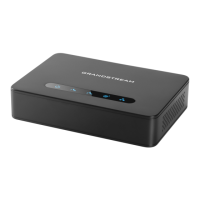HT812/HT814 Administration Guide
Determines payload type for iLBC. The valid range is between 96 and 127. Default is 97.
Determines payload type for OPUS. The valid range is between 96 and 127. Default is
123.
Allows detecting the absence of audio and conserves bandwidth by preventing the
transmission of "silent packets" over the network. Default is No.
Changes the destination to send RTP packets to the source IP address and port of the
inbound RTP packet last received by the device. Default is No.
Specifies the fax mode : T.38 (Auto Detect) FoIP by default, or Pass-Through (must use
codec PCMU/PCMA)
Re-Invite after Fax
Tone Detection
Mode
Permits the unit to send out the re-INVITE for T.38 or Fax Pass Through if a fax tone is
detected. Default is Enabled
Selects jitter buffer type (Fixed or Adaptive) based on network conditions.
High (initial 200ms, min 40ms, max 600ms) Note: not all vocoders can meet the
high requirement.
Medium (initial 100ms, min 20ms, max 200ms).
Low (initial 50ms, min 10ms, max 100ms).
Selects SRTP mode to use (“Disabled”, “Enabled but not forced”, or “Enabled and
forced”). Default is Disabled
It uses SDP Security Description to exchange key. Please refer to
SDES: https://tools.ietf.org/html/rfc4568
SRTP: https://www.ietf.org/rfc/rfc3711.txt
Adds crypto life time header to SRTP packets. Default is Yes.
Depends on standard phone type (and location).
Selects the caller id scheme, for example : Bellcore/Telcordia, ETSI-FSK …
Defines the start and stop tones.
Reverses the polarity upon call establishment and termination. Default is No.
Allows the traditional PBX used with HT812/HT814 to apply this method for signaling call
termination. Method initiates short voltage drop on the line when remote (VoIP) side
disconnects an active call. Default is No.
Configures the duration of voltage drop described in topic above. HT812/HT814 support

